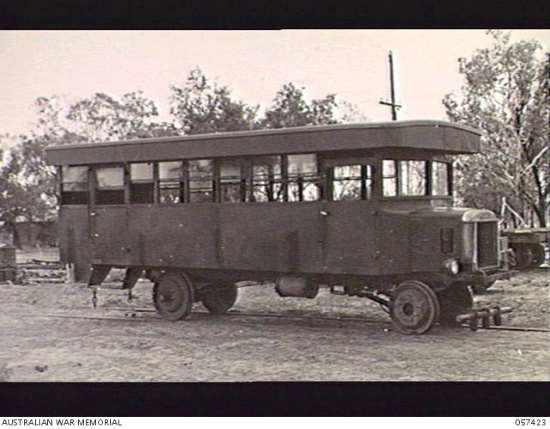A Wartime Railcar

The Leyland Lynx railcar photographed at Katherine during WWII
The need to move troops and goods as well as normal paying passengers during World War II placed an incredible burden on railways in Australia. Some lines that had been relatively sleepy backwaters suddenly became major arteries that were vital to the defence of the nation.
Perhaps the line that was least prepared for the task that had been thrust upon it was the 508km long North Australia Railway (NAR) that ran from Darwin south to Birdum. This line had been built by the Commonwealth Government and was operated by the Commonwealth Railways.
The 1067mm gauge line was opened in stages from 1889 to 1929 and the original intention was for the line to reach Alice Springs but the NAR never reached its final destination and the last train on the NAR ran in 1976.
Years later Darwin was connected by a standard gauge rail link to the rest of Australia and today heavy freight trains and modern airconditioned passenger trains run regular services but when World War II arrived on Australia’s doorstep the NAR was not ready for it.
Services were infrequent, the locomotive fleet was small and old … the very first loco to operate on the line was still in regular use. Haulage capacity was limited and suddenly the NAR was embroiled in a war that it certainly wasn’t ready for.
Construction of new locomotives was out of the question. The NAR needed locomotives fast and they couldn’t wait for them to be built so they were sourced from other 1067mm gauge railways around Australia.
But not everything could be borrowed or bought from other railways. Passenger traffic on the NAR had never been huge and at one time had been handled by a small fleet of passenger carriages and a single Sentinel steam railcar.
Unfortunately by the time war arrived in 1942 the Sentinel steam railcar was out of service. An accident in 1936 had damaged it beyond repair and it had never been replaced. However, when war arrived so did the need for a small passenger carrying vehicle and this time the Army stepped in to find a solution.
The Army’s solution was a Leyland Lynx 3 tonne (approx.) truck chassis. The rubber road tyres were replaced with flanged wheels and a body, similar to that of a bus, was added to the chassis. The new railcar arrived in 1941 and was immediately placed in service where it was operated by railway staff.
It could carry up to 25 passengers and was often coupled to a small van that had been originally used with the steam railcar.
After the war ownership of the Leyland Lynx was passed to the Commonwealth and it remained in frequent service up until 1953 and was probably scrapped sometime after 1954.
The Leyland Lynx would make a rather interesting modelling project. Finding a single-axle power unit would be a challenge but not impossible. Perhaps the biggest challenge would be finding a plan.
Technical Details:
Length over coupling points: 24ft 9.5 inches
Total weight: 4 tons 8cwt
Fuel capacity: 24 gallons
Maximum speed: 30mph
In the above photo the Leyland Lynx railcar is not fitted with a cowcatcher however photos do exist that show a plain, sheetmetal cowcatcher fitted to the front of the vehicle.
Bibliography
Port Dock Railway Museum (1996). Locomotives and Railcars of the Commonwealth Railways: Gresley Publishing.
Photo courtesy of the Australian War Memorial